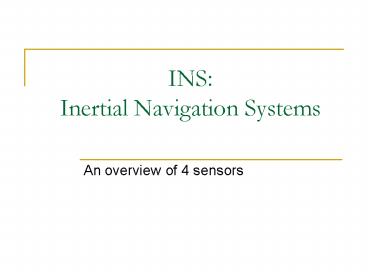INS: Inertial Navigation Systems - PowerPoint PPT Presentation
1 / 24
Title:
INS: Inertial Navigation Systems
Description:
... in the same direction Mounting in a set of gimbals allows us to measure the rotation of the body Tuning Fork Gyroscope Vibrating Ring Gyroscope w ... – PowerPoint PPT presentation
Number of Views:484
Avg rating:3.0/5.0
Title: INS: Inertial Navigation Systems
1
INS Inertial Navigation Systems
- An overview of 4 sensors
2
What is an INS?
- Position (dead reckoning)
- Orientation (roll, pitch, yaw)
- Velocities
- Accelerations
3
Sampling of INS Applications
4
Accelerometers
5
Accelerometers
- F ma
- (Newtons 2nd Law)
- F kx
- (Hookes Law)
6
Accelerometers
- C e0A/d
- (parallel-plate capacitor)
- e0 permitivity constant
- Q CV
Voltage ? Capacitance ? Surface Area and distance
? Spring displacement ? Force ?
Acceleration Integrate to get velocity and
displacement
7
Gyroscopes
8
Gyroscopes
How does it maintain angular orientation?
Disk rotating
Disk stationary
Disk on an axis
Red pen indicates applied force
9
Gyroscopes Precession
These points rotate and continue to want to
move in the same direction causing precession
- As green force is applied to axis of
rotation, red points will attempt to move in blue
directions
Rotating around red axis, apply a moment around
axis coming out of paper on red axis
10
Gyroscopes Gimbaled
- Rotor Axle wants to keep pointing in the same
direction - Mounting in a set of gimbals allows us to measure
the rotation of the body
11
Gyroscopes MEMS
- Coriolis effect fictitious force that acts
upon a freely moving object as observed from a
rotating frame of reference
12
Gyroscopes MEMS
- Comb drive fingers can be actuated by applying
voltage - Coriolis effect induces motion based on rotation
- Capacitive sensors (similar to accelerometers)
detect the magnitude of this effect and therefore
the rotation
Vibrating Ring Gyroscope
Tuning Fork Gyroscope
13
Fiber Optic Gyroscope (FOG)
DSP 4000
w attitude rate, 1 laser light source, 2
beamsplitter, 3 wound optical fiber, 4
photosensor.
turret, antenna, and optical stabilization
systems
14
GPS Global Positioning System
- Constellation 27 satellites in orbit
- Originally developed by U.S. military
- Accuracy 10 m
- 3D Trilateration
15
GPS 2D Trilateration
A
B
50 mi
75 mi
C
You are here
30 mi
16
GPS 3D Trilateration
- Location of at least three satellites (typically
4 or more) - Distance between receiver and each of those
satellites - Psudo-random code is sent via radio waves from
satellite and receiver - Since speed of radio signal is known, the lag
time determines distance
17
GPS Improvements
- Some sources of error
- Earths atmosphere slows down signal
- Radio signal can bounce off large objects
- Misreporting of satellite location
- Differential GPS (DGPS)
- Station with known location calculates receivers
inaccuracy - Broadcasts signal correction information
- Accuracy 10 m
18
GPS Improvements
- WAAS (Wide Area Augmentation System)
- Similar to DGPS
- Geosynchronous Earth Orbiting satellites instead
of land based stations - Accuracy 3 m
19
Encoders
20
Encoders Incremental
Photodetector
Encoder disk
LED Photoemitter
21
Encoders - Incremental
22
Encoders - Incremental
- Quadrature (resolution enhancing)
23
Encoders - Absolute
- More expensive
- Resolution 360 / 2N
- where N is number of tracks
4 Bit Example
24
Pros and Cons
Pros Cons
Accelerometer Inexpensive, small Integration drift error
Gyroscope Large selection Integration drift error
GPS No drift Data at 1 Hz
Encoders Inexpensive Slip

